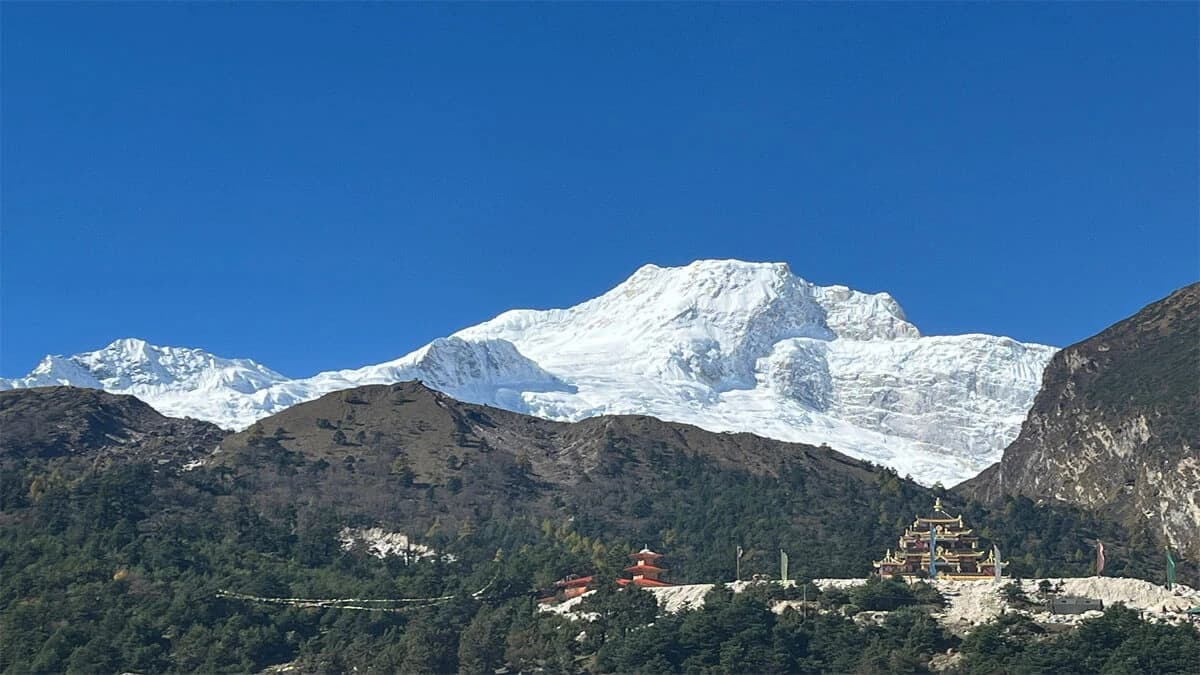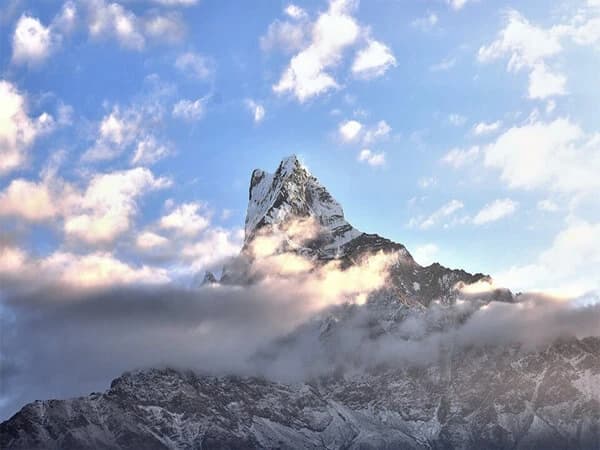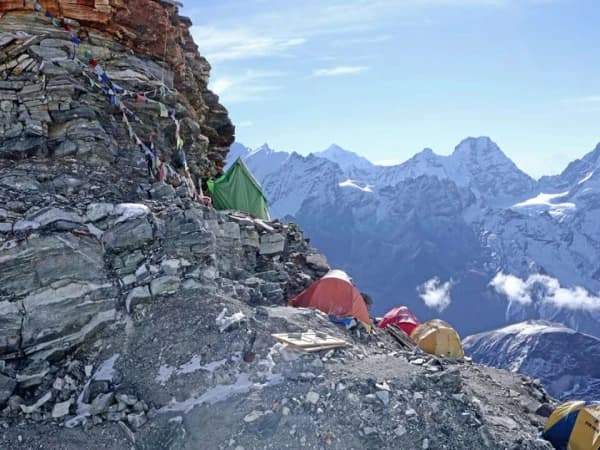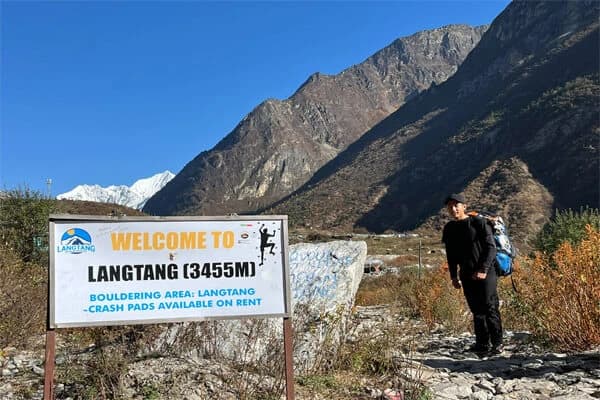Nepal attracts tourists with its people, culture, and spirit in addition to its majestic Himalayas. While villages and teahouses provide warmth and a sense of community, the mountains evoke wonder and introspection. Shared meals and laughter generate lifelong memories, and festivals, temples, and monasteries reflect a rich spiritual tradition. Eco-conscious travel strengthens a sense of purpose, while adventure and trekking rejuvenate the body and soul. Nepal leaves a lasting impression, whether it is through the discovery of hidden valleys or the sunrise above Everest.
Hearts in the Himalayas: Falling in Love with Travel to Nepal
What is it about Nepal that makes every visitor fall deeply in love? Perhaps it is the tranquil pace of life that flows through each mountain village or the sight of the snow-capped Himalayas rising against the blue sky. Nepal is more than just a place to visit; it is an experience that lingers in your memory for a long time. The nation greets you with monks chanting in far-off monasteries, prayer flags flapping in the breeze, and friendly grins from strangers treated like family.
Every step you take in Nepal feels like a silent exploration of your surroundings, culture, and self. There is a profound sense of connectedness that is difficult to describe, whether you are trekking through the high passes, touring historic temples, or just taking in the sunset over the hills. This blog explores that relationship the feelings, beauty, and spirit that make Nepal one of the world's most remarkable destinations. It is about how the nation opens your heart, teaches you to be simple, and allows you to view the world and yourself in a different light.
Travel to Nepal: Where the Himalayas Touch the Soul
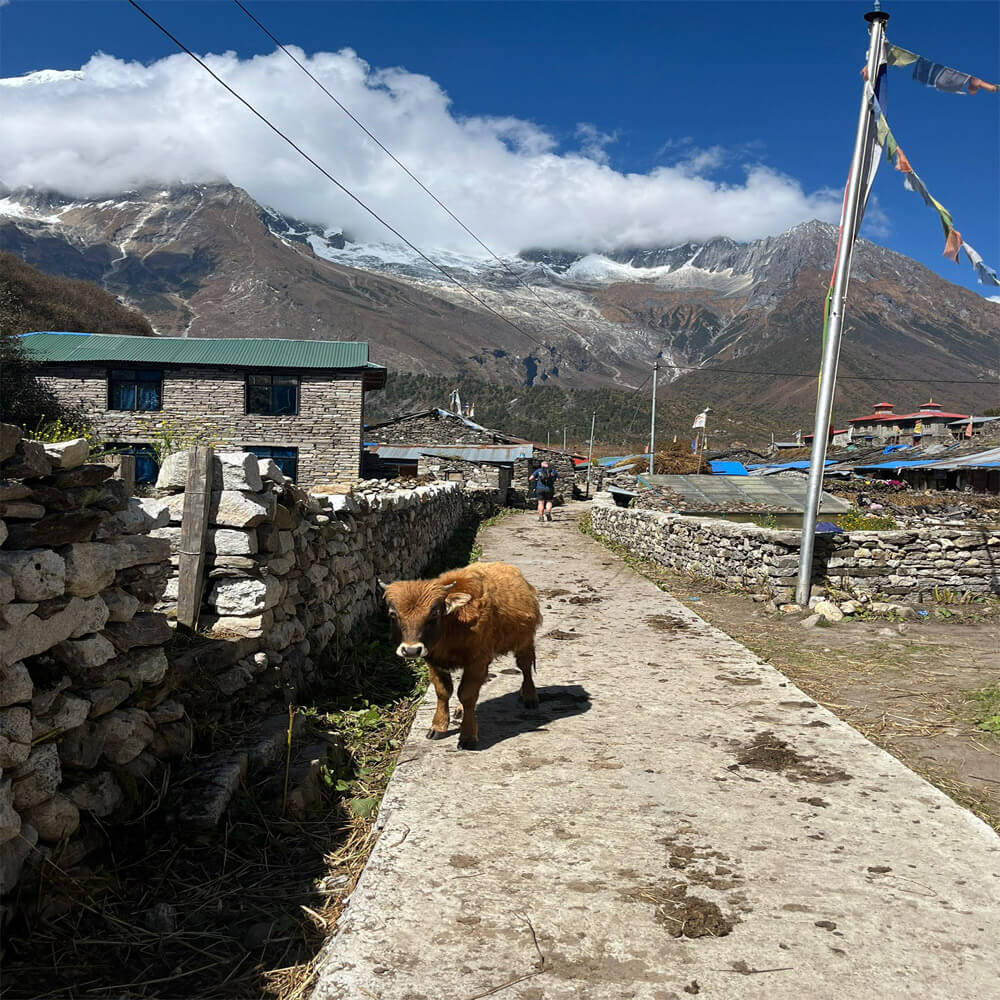
The striking ascent of Himalayas against the sky is a sight that is sure to move anyone visiting Nepal. These are symbols of the power and tranquility of nature, not simply mountains. It is nearly heavenly to stand in front of snow-capped peaks on a trek or to catch a first glimpse of them via the window of an airplane. The mountains appear to be alive with wisdom, stillness, and stories that make every visitor feel humbled.
A Land Sculpted by Giants
The Himalayas have a dominant role in geography of Nepal, influencing not just its scenery but also its people, culture, and climate. Trekking trails such as the Annapurna Circuit, Langtang Valley, and Everest Base Camp show how magnificently life clings to the untamed landscape. Trails run between high-altitude passes and rhododendron forests, villages sit on steep hillsides, and prayer flags flutter in the chilly wind. It is like strolling through a living painting when you travel here; there is something more breathtaking around every corner.
Sunrise Over the Roof of the World
Seeing the Himalayan sunrise is one of the most memorable things you can do when visiting Nepal. It is indescribable to witness the first light hitting the snow-capped summits of Everest, Lhotse, or Machapuchare. Poon Hill, Kala Patthar, and Nagarkot are among the places with some of the world's outstanding dawn vistas. Time appears to stop when golden rays touch the mountains, and you get a sense of unfathomable calm that serves as a reminder of how tiny yet incredibly interconnected we are to this world.
Where Silence Speaks Louder Than Words
In addition to being breathtakingly beautiful, the Himalayas are also incredibly quiet locations. The silence of high-altitude routes, away from noise and traffic, allows you to clearly hear your own thoughts. Many tourists say that their trip through the highlands is meditative, a period of introspection and inner peace. For this reason, a lot of spiritual searchers visit Nepal in search of adventure, balance, and purpose.
Awe and Adventure Combined
Every mountain flight or trek offers a unique combination of wonder and difficulty. A profound sense of thankfulness counterbalances the adrenaline rush, whether you are climbing up rugged routes, crossing suspension bridges over glacial rivers, or taking a picturesque helicopter flight above Everest. It is simple to see why Nepal's peaks captivate travelers from all over the world; they both physically and spiritually test you.
The Himalayas as a Way of Life
The mountains are not far away or frightening to Nepalis; rather, they are their home. These vast landscapes coexist peacefully with Sherpas and highland settlements. Long after they depart, tourists might learn from their tenacity, humility, and delight. The relationship between the people and the mountains one of mutual respect, reverence, and coexistence is just as captivating as the country's natural beauty when you visit Nepal.
The Emotional Pull of the Peaks
The way the mountains make you feel is ultimately what makes them so magical. They evoke wonder, demand reverence, and provide peaceful solace. The Himalayas evoke a deep sense of tranquility, wonder, and love, whether you are feeling the wind at Thorong La Pass or looking at Everest from Tengboche Monastery. Going to Nepal turns become an awakening rather than just a vacation. The mountains speak to your heart, not your curiosity, and once you hear that call, it is hard to ignore.
The Warmth of the People
It does not take long to travel to Nepal and discover that the people of the country are just as beautiful as its mountains and temples. Every greeting, smile, and deed of kindness conveys a sincere tale of generosity. No matter where you are on a busy boulevard in Kathmandu or a tiny town in the hills Nepalis have a knack of making you feel at home. Their kindness comes naturally from the richness of their culture and the ease of their everyday existence.
Genuine Hospitality and Open Hearts
The natural kindness that is present in every aspect of daily life in Nepal is among the first things visitors notice when they arrive. Here, the saying "guests are gods" is well known. It is a living value, not merely a catchphrase. Locals extend a warm welcome to visitors, frequently providing food, tea, and a place to sleep without asking anything in return. Families cook home-cooked meals and tell mountain stories in teahouses along trekking paths with an authenticity that is uncommon in modern travel experiences.
Conversations about dreams, family, and regional folklore will captivate you. There is a silent understanding that kindness is more than words, even if people do not speak the same language.
Smiles That Stay With You
Elders smile with mild pride and children wave from doorsteps as you pass through villages like Ghandruk, Namche Bazaar, or Langtang. These little things frequently turn into the beating heart of your adventure. Many visitors claim that these experiences are what they remember most after leaving Nepal, even more so than the breathtaking views of Everest or the elaborate temples of Kathmandu.
The way Nepalis smile is captivating; it is not merely politeness; it is warmth based on simplicity and thankfulness. It is the kind of smile that serves as a reminder of what really counts: presence, not perfection; connection, not convenience.
Lessons from Simplicity
The modest grace with which the people of Nepal live is a reflection of equilibrium and contentment. Despite the harsh conditions of mountain life steep trails, chilly nights, and scarce resources the sense of camaraderie endures. When you visit Nepal, you see a quiet strength in the way people help one another, celebrate together, and maintain their optimism in the face of adversity.
Every helpful hand on a rough path or every shared cup of tea contains a lesson. You come to see that connection and thankfulness are all that are necessary for happiness. After visiting Nepal, tourists frequently remark that they leave with more than simply pictures or mementos; they also bring perspective.
An Enduring Relationship
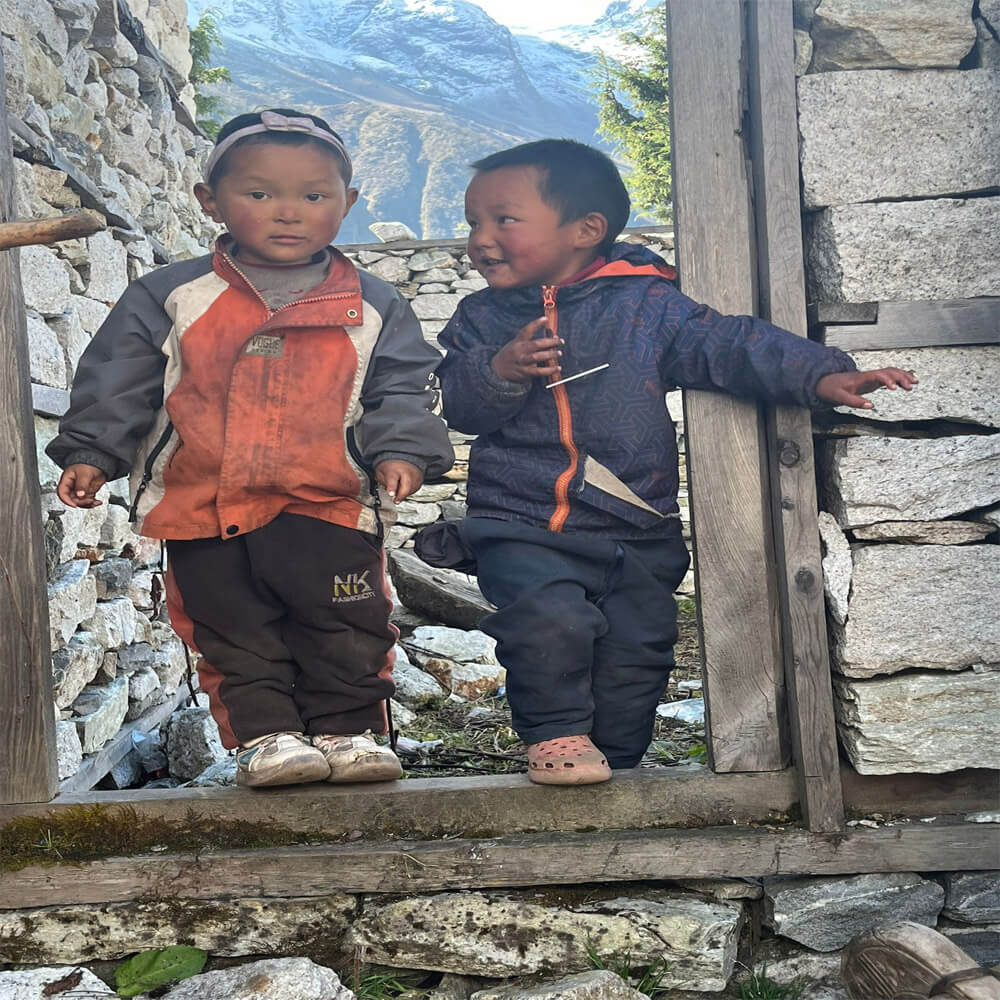
The ease with which the locals fit into your narrative is what makes travel to Nepal so remarkable. Arriving as a tourist, you depart with a sense of belonging. Long after the vacation is finished, the connections formed during calm mountain walks, festival dances, or shared dinners endure.
It is difficult to explain, yet it seems like Nepal contributes more than it receives. Few places can give you a sense of belonging like the friendliness of its people. It is the reason so many tourists return, not only for the mountains but also for the people who make them feel like home.
Cultural Charm and Spiritual Depth
Nepal's culture and mountains both have a deep, timeless rhythm that is influenced by daily rituals, art, and spirituality. Everywhere in the nation, there are rumors of gods, spirits, and old customs that still influence contemporary living. Feeling Nepal's cultural pulse, which permeates temples, festivals, and interpersonal relationships that are indescribable, is essential to falling deeply in love with the country.
Where Life and Faith Meet
In Nepal, spirituality affects every aspect of daily life and is not limited to temples. Faith permeates everything, from the glow of an oil lamp at sunrise to the sound of prayer wheels spinning in the breeze. In locations like Boudhanath Stupa, where monks circle in meditation, and Pashupatinath Temple, where devotees chant by the Bagmati River, the air itself seems sacred.
Here, Buddhism and Hinduism coexist as two melodies that blend harmoniously together rather than as opposites. You will witness Buddhist prayer flags flying over Hindu shrines and both Hindu and Buddhist devotees presenting flowers to the same god. Nepal has a spiritual warmth that brings serenity to even strangers because of this confluence of traditions.
Temples That Tell Timeless Stories
It is like entering a live museum when you enter the courtyards of Kathmandu Durbar Square or the historic lanes of Patan. With their elaborate wooden carvings, the pagoda-style temples serve as representations of creative skill and dedication. Every temple narrates a tale of monarchs, gods, and the religion that influenced the identity of this country.
Nestled peacefully on a hill, Changu Narayan is one of Nepal's oldest temples, its stones bearing inscriptions dating back hundreds of years. You may feel the presence of generations who have worshiped, celebrated, and grieved here as you stroll through these hallowed areas. It is about legacy, feeling, and belonging, not just religion.
The Colorful Joy of Festivals
Attend Nepal's festivals if you wish to experience its soul. Families are filled with reunions and joy thanks to Dashain. Tihar celebrates the relationship between people and animals by lighting the night with candles and affection. Holi, which represents freedom, love, and rebirth, saturates the streets with color.
Buddha Jayanti is a calm and thoughtful holiday that serves as a reminder to everyone of compassion and harmony. Every festival showcases a distinct aspect of Nepal's personality, which is one of joy, resiliency, and a strong bond with the natural world and its people. Locals welcome visitors into these moments, where they share food, music, and smiles with them as if they were family.
Everyday Spiritual Encounters
The smallest acts of spirituality in Nepal, such as a monk serving tea, a farmer blessing the first harvest, or a child spinning a prayer wheel before school, are just as significant as the well-known landmarks and elaborate celebrations. These modest, heartfelt deeds capture the subtle elegance of Nepalese religion.
Even in crowded Kathmandu, people would pause to lay a flower beside a roadside shrine or ring a temple bell. Many visitors come to the realization during these brief encounters that spirituality in this place is about being present, being grateful, and learning to slow down rather than elaborate rituals.
Falling in Love with Nepal’s Spirit
Nepal's rich cultural and spiritual heritage arouses love as well as admiration. The sound of temple bells, the aroma of incense, and the sincere goodwill of the populace all convey it. Nepal serves as a reminder that faith is a living, human, and communal experience, whether you are meditating at a monastery or watching the sunset prayers by a riverside.
Because of this link between culture and spirit, tourists frequently refer to Nepal as a sensation rather than just a place to visit. You learn how to be present, appreciate the beauty in every breath, and find joy in simplicity in this nation. And maybe that is why the Himalayas become a home to so many hearts.
Adventure That Awakens the Soul
Adventure travel in Nepal has a profoundly transforming effect. It is about finding strength you did not know you had, meeting individuals who make you think differently, and finding calm in the immense solitude of the Himalayas. It is not only about climbing mountains or crossing rivers. Every route, sunrise, and obstacle seems to be a conversation between your soul and the natural world.
Trekking: A Journey Within
In Nepal, trekking is a spiritual as well as a physical activity. As you follow twisting pathways through valleys, ridges, and forests, the cadence of your footsteps nearly becomes contemplative. Every trail has a unique tale to tell, from the fabled Everest Base Camp Trek to the tranquil Annapurna Sanctuary. Even while you may start out seeking views of snow-capped peaks, you may come to the realization that the journey is also about the people you meet, the tea you drink in mountain lodges, and the resilience you find within yourself. The beauty all around you uplifts your spirits, but the thin air pushes you to your limits. In Nepal, trekking is about developing a closer relationship with life rather than running away from it.
Thrill of Adventure Sports
In addition to trekking, the scenery of Nepal draws thrill-seekers from all over the world. Imagine experiencing the exhilaration and energy that come with each rapid as you float down the Trishuli River. Or flying like a bird above Phewa Lake while paragliding in Pokhara, where you can see the Himalayas in all directions. Extreme sports enthusiasts can experience an exhilarating rush by bungee jumping over the Bhote Koshi River or mountain biking across tough terrain. These experiences are more about present than they are about excitement. Pure awareness and joy replace the cacophony of daily existence during those few moments of terror or flight.
The Calm After the Challenge
Nepali experience is special because it consistently strikes a balance between excitement and peace. Travelers frequently find themselves pulled to calm thought after strenuous activities or lengthy excursions. They might sit beside a river that hums like a chant, meditate in a monastery in Tengboche, or watch prayer flags dance in the wind. The Himalayan beat incorporates this serenity. The land imparts humility, thankfulness, and patience. Even after a strenuous trek, fatigue frequently gives way to a profound sensation of calm that lasts long after you have returned home.
Adventure as a Path to Self-Discovery
In Nepal, every adventure has a subtle lesson. The ascent develops tenacity. It is a simple trail. Respect is required for the altitude. Visitors frequently come to Nepal in search of adventure, but they also depart with a deeper understanding of themselves.
Many people come to the realization that true adventure is about waking something inside of them rather than reaching the peak when they are standing at a high pass with prayer flags flying everywhere and the globe spread out below. That’s why Nepal’s adventures feel so soulful they invite you to face both the mountains outside and the mountains within.
Cuisine and Community Connections
In addition to the mountains and monasteries, traveling through Nepal is also about the meals you share and the people you encounter. In Nepal, food evokes memories of kinship, customs, and bonding. Every meal conveys warmth and a sense of community, whether you are eating in a little teahouse along a trekking path or sitting cross-legged in a rural kitchen.
Dal Bhat: The Heart of Every Meal
Dal Bhat, a straightforward but filling mix of rice, lentil soup, veggies, and pickles, is perhaps the cuisine that best embodies Nepal. "Dal Bhat power, 24 hour" is a common saying that refers to a way of life rather than a joke. Locals view dal bhat as a sign of welcome and sustenance, while trekkers use it as fuel. The diversity of dal bhat is what makes it so lovely; each home makes it in a unique way, including regional flavors and customs.
In addition to satisfying your hunger, eating dal bhat encourages you to calm down, appreciate what you have in front of you, and establish a connection with people who prepared it. When a family in the highlands gives you a hot dish of dal bhat, it is more than just food; it is a show of concern.
Momos and Mountain Tea Moments
Then there are momos, those tiny bursts of happiness. Serve these steamed or fried dumplings with a zesty tomato sauce and frequently contain spicy meat or vegetables. In Kathmandu, on the high Himalayan treks, or even in a little kitchen owned by a Sherpa family, momos may be found everywhere. Consuming momos is a social custom rather than just a snack. Cooking becomes a communal activity as people congregate, converse, laugh, and prepare momos together.
Not to mention tea, which is the essence of Nepali hospitality. With every cup comes a grin, whether it is salted butter tea in mountain villages or sweet milk tea in the cities. Friendships often start over over tea. Having your first drink by the fire with locals and other travelers after a long trek feels like a warm embrace from the Himalayas themselves.
Homestays and Teahouses: Where Strangers Become Family
It is simple to enter a home as a stranger in Nepal and emerge as a friend. Along trekking trails, homestays and teahouses provide environments that foster real human interaction. In addition to a bed, these tiny, family-run hotels provide companionship, stories, and laughing.
Around a wood stove, you might learn how to make chapati, assist with dinner preparation with your hosts, or exchange stories about the trek. Conversation, regional music, and the soft hum of the mountains outside are common sounds in the evenings. During these times, you come to understand that the true meaning of travel is not the sights you see, but rather the people you meet.
Food as a Cultural Bridge
Nepalese cuisine transcends generations and civilizations. Trekkers from all over the world and residents from a variety of ethnic origins, including Sherpas, Gurungs, Tamangs, Newars, and others, come together there. You can feel the straightforward, honest, and profoundly human rhythm of mountain life through food.
Every meal spent together turns into a tale that you will remember long after you have left. The spices remain in your mind as well as on your tongue. The kindness of a host who urged you take one more serving will always remain in your memory, even if you forget the altitude or the distance you traveled.
Love Stories in the Land of the Himalayas
Nepal is a sensation that subtly changes you, not just a place to visit. Many visitors come looking for adventure, but instead they discover something more profound: emotion, connection, and occasionally love. The Himalayan scenery has a way of uniting people, whether it is by sharing stories beneath a starry sky, laughing together in a little teahouse, or meeting other trekkers on a meandering mountain trail. The flow of life here has a subtle charm that makes people feel more alive and present. It is simple, raw, and authentic.
Falling in Love with the Land
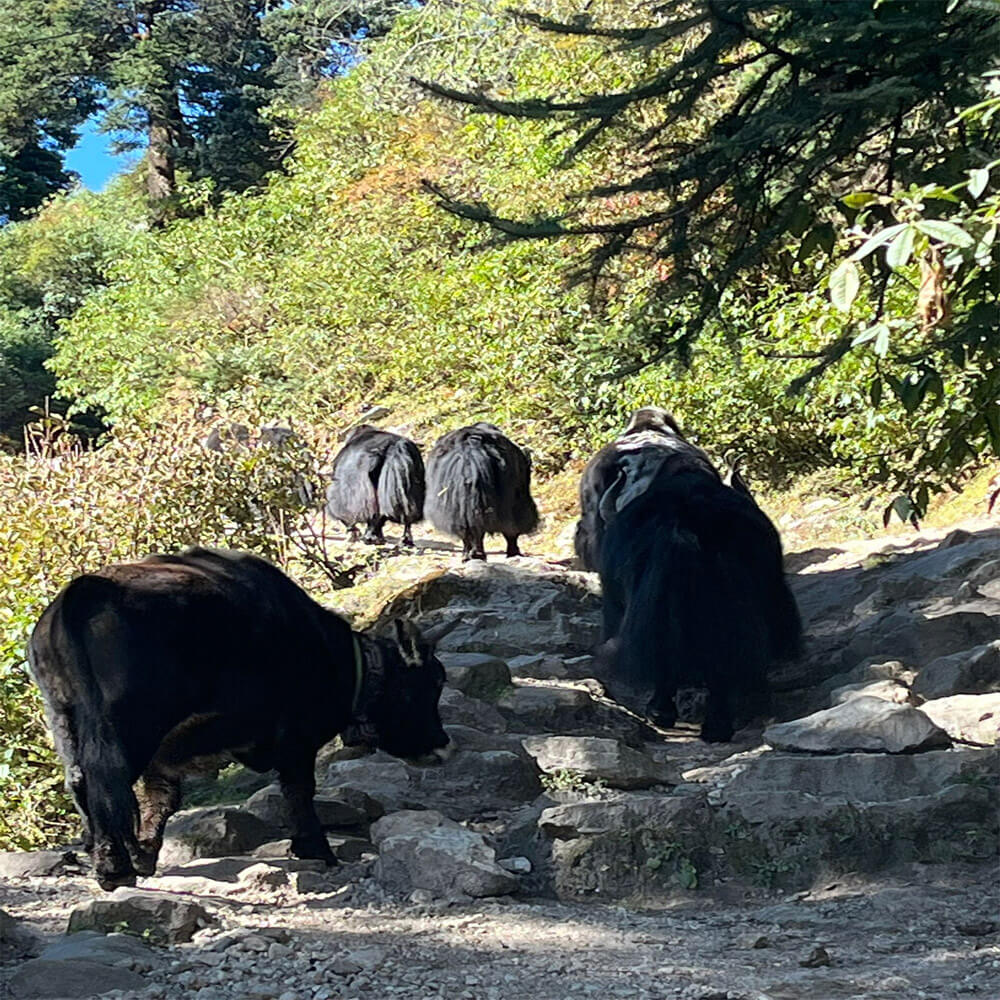
Many people in Nepal believe that the terrain itself is the subject of the greatest love tale, rather than a human. The sound of monks chanting in secret monasteries, the flutter of prayer flags against the chilly mountain wind, and the first glimpse of Everest at dawn all evoke strong emotions. The rhododendron trees' earthy aroma, the tranquility of the Himalayas, and the generosity of strangers who treat you like family captivate you. This type of love lingers in the heart like a gentle echo and does not go away after you go.
Romance in the Mountains
For couples and honeymooners looking for peace and purpose, Nepal has emerged as one of the most romantic destinations. Imagine drinking tea as the sun rises over snow-capped peaks while you wake up in a comfortable mountain lodge. Together, you may make lifelong memories trekking along beautiful routes like Langtang Valley, Everest View, and Ghorepani Poon Hill. Each step demonstrates not only the splendor of the mountains but also the power of friendship and trust, strengthening bonds between people.
A Journey of Self-Love and Discovery
Two persons are not always involved in love stories. Nepal frequently turns into a haven of healing and rediscovery for lone travelers. There is room for introspection because of the tranquility of the high-altitude trails and the slow pace of life here. Many people discover love within themselves in their fortitude, endurance, and patience. The journey teaches that love can be found in every sunrise, every smile, and every quiet moment of gratitude. In the end, the Himalayas remind us that love whether for nature, others, or ourselves is what gives travel its true meaning.
Sustainability and Giving Back
Feeling a connection to the country and its people that encourages duty and care is frequently the key to falling in love with Nepal, which transcends its natural beauty and cultural traditions. Many tourists come to understand that the greatest travel experiences involve more than just taking in the sights and sounds of a destination. Sustainable tourism and community engagement are two ways that Nepalese people express this sense of purpose.
Supporting Local Communities
Supporting local communities is one of the most fulfilling ways to give back. By selecting locally owned restaurants, resorts, and guides, tourists directly support local families. Responsible tourism, which keeps the money in the locals, has helped trekking routes like the Annapurna region and the Langtang Valley. Staying in family-run teahouses, eating home-cooked meals, and purchasing handcrafted goods all have a significant impact. These minor decisions support communities and preserve their customs.
Eco-Friendly Travel Practices
Both biologically and culturally, the Himalayas are extremely fragile. Responsible trekking contributes to the preservation of their natural beauty. These days, a lot of tourists opt for environmentally beneficial travel choices, such bringing reusable bottles, staying away from plastic, and participating in cleanup campaigns. Some treks even encourage participants to return with trash from the trails. Even though they are little, these acts preserve the pristine ecosystem and offer a strong message of respect for the mountains that have provided us with so much.
Volunteering and Cultural Exchange
Volunteering is another effective method to give back. Travelers can make a direct impact on Nepal's development by helping with conservation initiatives, earthquake reconstruction, or teaching English in mountain schools. Additionally, volunteering offers the opportunity to live, study, and develop alongside the locals, facilitating a profound cultural interaction. More often than not, this shared experience results in memories and friendships that last a lifetime.
Travel with Purpose
Nowadays, tourists are more conscious of their impact and are looking for meaningful travel experiences. In Nepal, being sustainable means adding heart to adventure rather than sacrificing it. Every ethical deed, like planting a tree, employing a local porter, or signing up with a fair-trade trekking organization, contributes to a larger tale of love with the Himalayas.
FAQs
What makes Nepal Trekking a romantic destination for Trekking?
Nepal combines breathtaking landscapes, serene mountains, vibrant culture, and warm hospitality. From sunrise over the Himalayas to peaceful monastery visits, it offers experiences that touch the heart, making it perfect for couples, honeymooners, or solo travelers seeking soulful connections. This makes Nepal trekking a romantic destination for trekking and tour
Can I plan a honeymoon tour in Nepal?
Yes! Destinations like Pokhara, Nagarkot, and the Annapurna region provide scenic retreats, adventure activities, and cozy lodges. Nepal’s mix of nature, culture, and adventure creates unforgettable honeymoon touring experiences.
Are there cultural experiences for travelers to connect deeply?
Absolutely. Festivals, temple rituals, homestays, and village visits let travelers engage with Nepali traditions, fostering meaningful interactions and emotional connections with local communities.
Is Nepal suitable for adventure-loving couples?
Definitely. Trekking, paragliding, rafting, and wildlife safaris provide shared adventures that strengthen bonds while immersing couples in the majestic Himalayas.
How can I explore Nepal safely and responsibly?
Hiring licensed guides and local agencies, such as Nepal Trekking Routes, ensures safety, legal compliance, and meaningful experiences. Responsible travel practices like respecting customs and minimizing environmental impact make the journey both memorable and ethical.
Conclusion: Travel to Nepal
Long after your trip is over, Nepal remains in your memory. The majestic Himalayas, tranquil valleys, and meandering paths create a lasting impression on the emotions as much as the eyes. Beyond its natural beauty, what leaves a lasting impression are the friendly locals, the colorful celebrations, and the ecstasy of the temples and monasteries. Every trek, village visit, and supper together contributes to a personal narrative that tourists take back with them. Nepal is more than just a place to visit; it is a cultural and mountain-based love letter that evokes strong emotions. You can securely, thoroughly, and wonderfully explore these hidden gems with the help of Nepal Trekking Routes.

